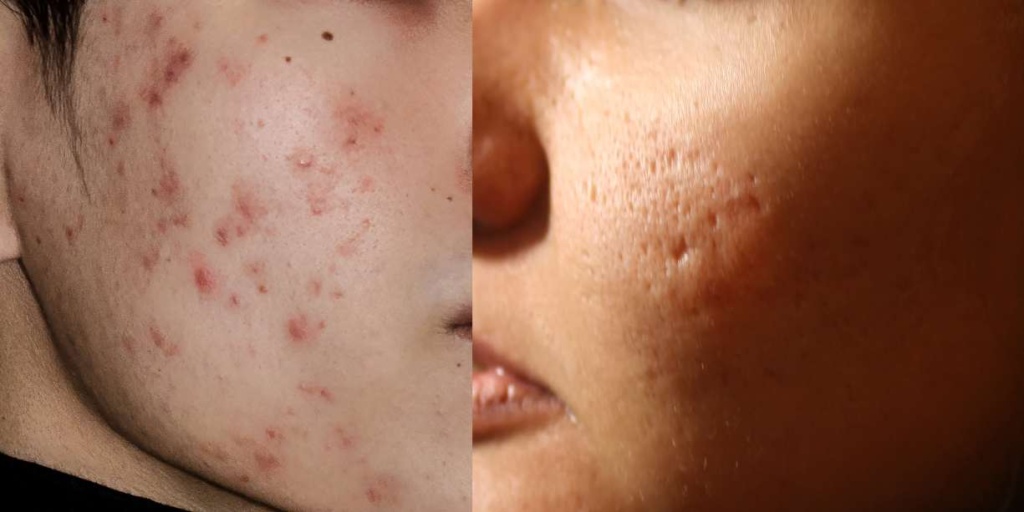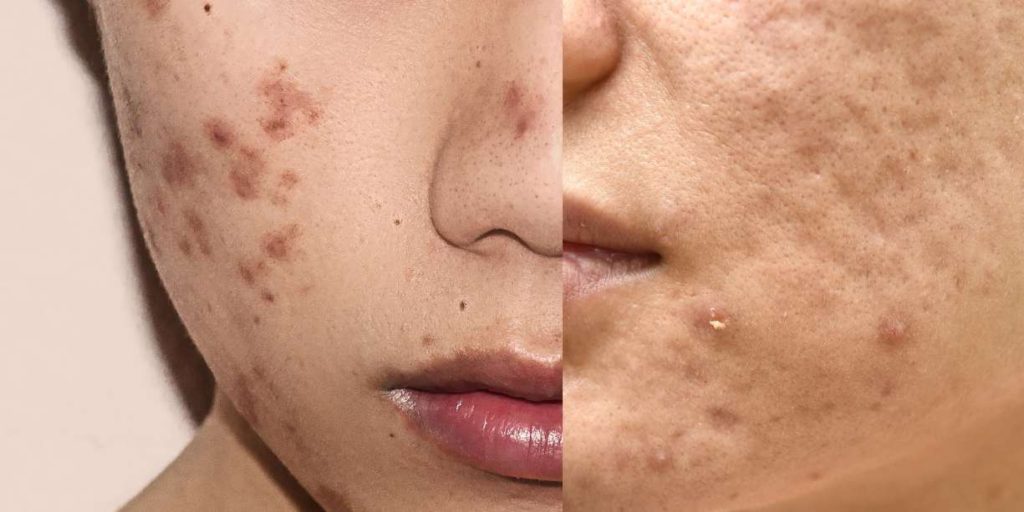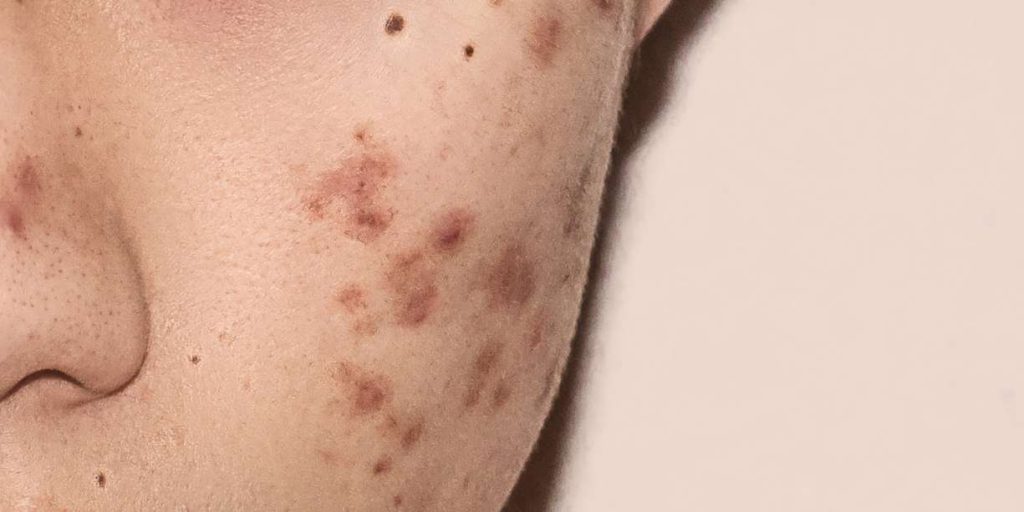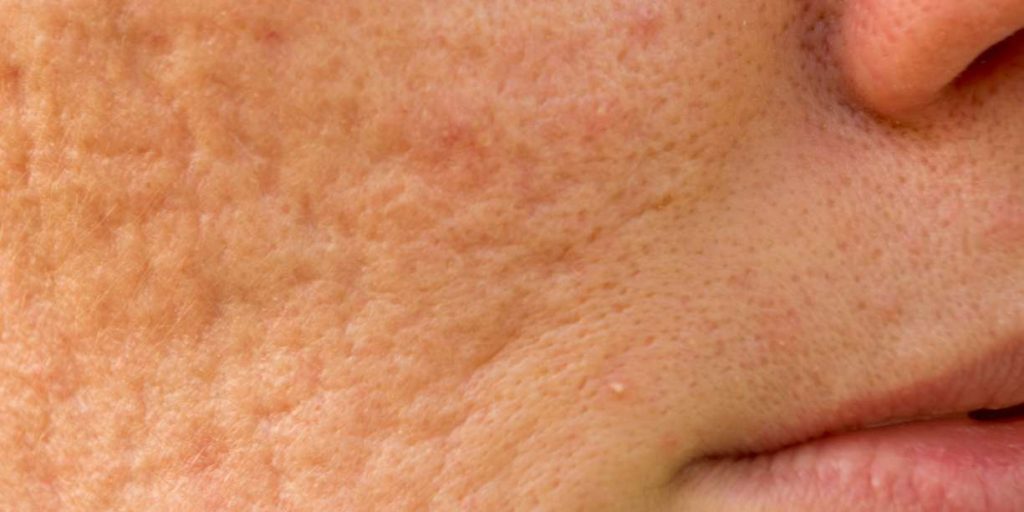Acne Marks vs. Acne Scars: Understanding the Battlefield of Blemishes
When it comes to acne aftermath, two terms often cause confusion: acne marks and acne scars. These battle souvenirs from breakouts may seem similar, but there are crucial differences.
- Acne Marks: The Temporary Tattoos Also known as post-inflammatory hyperpigmentation, acne marks are flat, discolored spots that can linger after a pimple has healed.
- Color: They typically appear red, pink, brown, or even purple, depending on your skin tone and the inflammation degree.
- Duration: Think of them as temporary tattoos. While they might stick around for several months, they usually fade over time without treatment.
- Treatment: However, if you’re impatient to see them gone, topical creams, chemical peels, or laser treatments can help accelerate the fading process.
- Acne Scars: The Permanent Reminders Acne scars are the result of inflammatory acne (think large, red, and painful) that cause damage to the skin’s deeper layers.
- Appearance: Unlike flat acne marks, scars are either raised (hypertrophic or keloid scars) or indented (atrophic scars). They create a texture change in the skin.
- Duration: These are the permanent reminders of past battles against breakouts, although their appearance can lessen over time.
- Treatment: Treatments for acne scars are often more intensive and can include dermal fillers, laser resurfacing, or even surgical procedures.
To sum it up, acne marks are like fading footprints on a sandy beach, while acne scars are more like footprints in cement – deeper, permanent, and harder to erase. Understanding the difference can help you choose the best treatment strategy and help your skin regain its smooth, clear battlefield after the acne war.

Introduction
Dealing with acne can be quite frustrating, especially when it comes to differentiating between acne marks and acne scars. These two skin imperfections often get mistaken for each other, but understanding their differences is crucial in determining the most effective treatment approach.
In this blog post, we’ll dive into the causes and appearances of acne marks vs. acne scars while exploring various treatment options that can help you achieve smooth skin.
Acne Marks vs. Acne Scars – Key Takeaways
- Acne marks are temporary flat, discolored spots that appear after a breakout and generally fade over time on their own without treatment. In contrast, acne scars have a more permanent impact on skin texture and require targeted treatments for improvement.
- Both types of acne marks and scars are primarily caused by inflammation due to clogged pores with oil or bacteria. Other factors like hormonal changes, genetics, and environmental conditions can also contribute to acne marks and scars development.
- Treatment options for both acne marks and scars include topical treatments like retinoids and hydroquinone, chemical peels, microdermabrasion, medical treatments such as microneedling or dermal fillers (depending on scar type), surgical procedures like subcision for raised scarring, as well as home remedies using natural ingredients. Consult with a dermatologist to determine the most appropriate course of action based on individual needs.
- To prevent further damage from occurring it’s important to seek professional medical advice early if you’re struggling with persistent acne or developing either type of imperfection; avoid picking at pimples; wear sunscreen daily when using certain topical treatments like retinoids or hydroquinone which can make your skin more sensitive to the sun; use non-comedogenic products formulated specially for those prone to breakouts & maintain good skincare hygiene habits in general!
Understanding Acne Marks Vs Acne Scars

Acne marks and acne scars are two types of skin imperfections caused by inflammation, but they differ in appearance, causes, and required treatments.
Definition And Differences In Appearance
Acne marks and acne scars are often used interchangeably; however, they refer to two distinct skin imperfections caused by inflammation. Acne marks, also known as post-inflammatory hyperpigmentation, are generally flat and discolored spots that appear after a breakout begins to heal.
These marks can vary in color from red to brown or even purple, depending on your skin tone.
In contrast, acne scars result from more severe breakouts that cause damage to the skin’s collagen structure. There are two main types of acne scars: atrophic (or indented), which forms due to tissue loss; and hypertrophic (or raised), which occurs when an intense inflammatory reaction leads to excessive scar tissue formation.
Unlike acne marks, these scars have a more permanent impact on skin texture and require targeted treatments for improvement.
Causes And Risk Factors
Acne marks and acne scars are primarily caused by inflammation that occurs when the skin’s pores become clogged with oil, dirt, or bacteria. Other factors that can contribute to the development of acne marks and scars include hormonal changes, genetics, and environmental conditions like exposure to UV rays.
The severity of an individual’s acne also plays a significant role in determining whether they will develop scarring or not. Those with more severe cases of acne are at higher risk for developing long-lasting scarring compared to those who experience mild breakouts.
Additionally, picking at pimples or other blemishes on the face can also increase the likelihood of developing both types of imperfections.
Treatment Options For Acne Marks

There are various treatment options available for acne marks, including topical treatments like retinoids and hydroquinone, as well as chemical peels and microdermabrasion.
1. Topical Treatments (retinoids, Hydroquinone)
Topical treatments are a common option for addressing acne marks. Retinoids and hydroquinone are two popular options that can help reduce discoloration and restore even skin tone. Here’s what you need to know:
- Retinoids work by increasing cell turnover, which can help fade dark spots left behind by acne. Prescription-strength retinoids like tretinoin are the most effective, but over-the-counter versions like adapalene can also be helpful.
- Hydroquinone is a skin-lightening agent that inhibits the production of melanin, which is responsible for pigmentation. It can be found in concentrations up to 2% in over-the-counter products, but prescription-strength formulations may be available as well.
- Both retinoids and hydroquinone can make your skin more sensitive to the sun, so it’s important to wear sunscreen daily and avoid direct sunlight as much as possible while using them.
- Other topical treatments that may be helpful include vitamin C serums, niacinamide, and azelaic acid. These ingredients can help brighten the skin and reduce inflammation.
While topical treatments can be useful for treating acne marks, they may not be as effective when it comes to treating acne scars. More severe scarring may require more intensive treatments like laser therapy or dermal fillers. However, if you’re dealing with mild to moderate discoloration caused by acne marks, incorporating retinoids or hydroquinone into your skincare routine could help improve your complexion.
2. Chemical Peels
Chemical peels are a treatment option for those looking to reduce the appearance of acne marks. The peel works by removing the top layer of skin, revealing fresher skin underneath that has not been affected by acne.
Chemical peels can also help fade hyperpigmentation and smooth out rough skin texture caused by acne scarring.
There are different types of chemical peels available, ranging from mild to deep penetration levels depending on the severity of discoloration and scarring.
Mild acids like glycolic or salicylic acid can be used at home but stronger acids will require a professional treatment with an aesthetician or dermatologist. It’s important to note that while chemical peels can improve the appearance of your skin, it does carry risks such as redness, irritation and even temporary burns (depending on the level used).
3. Microdermabrasion
Microdermabrasion is a non-invasive procedure that uses a tool to gently exfoliate the top layer of skin. It can be effective for treating acne marks as it helps to remove dead skin cells, allowing new, healthy cells to grow and reducing the appearance of discoloration.
During the procedure, tiny crystals are used to buff away the outermost layer of skin, improving texture and promoting collagen production.
It’s worth noting that while microdermabrasion can help improve skin texture and reduce discoloration, it may not be sufficient for more severe cases of acne scars.
In such instances where deeper scarring is present, other treatments may be necessary such as laser therapy, chemical peels or dermal fillers.
4. Natural Remedies
There are various natural remedies that may help fade acne marks and scars. Here are some options to consider:
- Aloe vera: This plant has anti-inflammatory and healing properties that may help reduce redness and promote skin healing.
- Tea tree oil: Known for its antibacterial properties, tea tree oil may help prevent breakouts and reduce the appearance of scars.
- Agave nectar: Similar to honey, agave nectar has natural healing properties and can be used as a mask or spot treatment. It’s a plant-based sweetener that can help moisturize and soothe the skin.
- Lemon juice: The acidic nature of lemon juice can help exfoliate the skin and fade hyperpigmentation caused by acne marks.
- Coconut oil: Applying coconut oil to the affected area may help provide moisture and nutrients to the skin, promoting healing and reducing scarring.
It’s important to note that while natural remedies can be helpful, they may not be as effective as medical treatments for more severe cases of acne marks and scars. It’s always best to consult with a dermatologist for personalized treatment recommendations.
Treatment Options For Acne Scars

Medical treatments like microneedling, dermal fillers, and laser resurfacing can be effective for treating atrophic acne scars, while surgical procedures such as subcision can help with raised acne scars.
1. Medical Treatments (microneedling, Dermal Fillers, Laser Resurfacing)
Medical treatments for acne scars can be highly effective in improving the appearance of the affected area. Here are some of the most popular medical treatment options available:
- Microneedling: This procedure involves using a device with tiny needles to create micro-injuries in the skin, which stimulates collagen production and helps improve skin texture.
- Dermal fillers: These injections can be used to fill in depressed scars and create smoother skin texture.
- Laser resurfacing: This treatment uses laser technology to remove damaged outer layers of skin, revealing fresher, smoother-looking skin underneath.
It’s important to note that these medical treatments should only be performed by a licensed dermatologist or other trained medical professional. It’s also important to discuss any potential risks or side effects with your doctor before undergoing any treatment.
2. Surgical Procedures (subcision)
Subcision is a surgical procedure that involves the use of a special needle to break up tough scar tissue beneath the skin’s surface. This technique helps to release those tethered scars and allow new collagen to grow, leading to improved skin texture.
It is an excellent option for treating atrophic acne scarring such as rolling, boxcar or ice-pick scars.
In conclusion, while subcision may not be appropriate for everyone who has acne scars, it can be effective in improving the appearance of certain types of scarring.
3. Home Remedies
There are various home remedies that can be used to help fade acne marks and scars naturally. These remedies include:
- Aloe Vera: The anti-inflammatory properties of aloe vera can help soothe the skin and reduce inflammation, which can improve the appearance of acne marks and scars over time.
- Lemon Juice: The natural acids in lemon juice can help lighten dark spots and hyperpigmentation caused by acne. Simply apply freshly squeezed lemon juice to the affected area with a cotton ball and leave it on for 10-15 minutes before rinsing off.
- Agave Nectar: Similar to honey, agave nectar has natural healing properties and can be used as a mask or spot treatment. It’s a plant-based sweetener that can help moisturize and soothe the skin. Apply a thin layer of agave nectar to the affected area for 10-15 minutes before rinsing off.
- Tea Tree Oil: The natural antimicrobial properties of tea tree oil make it an effective treatment for active breakouts that can lead to scarring.
- Apple Cider Vinegar: Diluted apple cider vinegar can help exfoliate dead skin cells, which can improve overall skin texture and reduce the appearance of acne marks over time.
It’s important to note that while home remedies may be helpful in fading both acne marks and scars, they may not be as effective as medical treatments or procedures. It’s always best to consult with a dermatologist for advice on the most appropriate treatment options based on your specific needs and skin type.
Prevention And Management Of Acne Marks And Scars
To prevent and manage acne marks and scars, it is important to have a proper skin care routine, avoid triggers and aggravating factors such as picking at the skin, use sun protection to avoid further darkening or discoloration of the affected area, and consult with a dermatologist for personalized treatment options.
Proper Skin Care Routine
One of the most crucial steps in preventing and managing acne marks and scars is maintaining a proper skin care routine. Here are some tips:
- Wash your face twice a day with a mild cleanser to remove excess oil, dirt, and makeup that can clog pores and cause breakouts.
- Avoid using harsh scrubs or exfoliants that can irritate the skin and worsen inflammation.
- Use non-comedogenic (non-pore-clogging) products, especially moisturizers and sunscreens.
- Apply sunscreen daily to protect against UV rays that can worsen hyperpigmentation.
- Avoid picking, squeezing, or popping pimples as it can lead to more inflammation and scarring.
- Use topical treatments as directed by your dermatologist to help control acne.
Following these basic guidelines for a proper skin care routine can go a long way in reducing the risk of developing acne marks or scars.
Avoiding Triggers And Aggravating Factors
To prevent acne marks and scars from developing, it is important to avoid triggers and aggravating factors that can worsen acne breakouts. These may include certain foods, such as dairy products or chocolate, hormonal changes during menstrual cycles, stress, and using harsh skincare products.
It is also essential to keep the skin clean by washing twice a day with a gentle cleanser and avoiding picking at pimples or blemishes. Using non-comedogenic makeup and keeping hair away from the face can also help reduce the risk of breakouts.
Sun protection is crucial for preventing hyperpigmentation in acne-prone skin; therefore sunscreen must be used daily with an SPF 30+ to protect against harmful UV rays.
Sun Protection
Sun protection is crucial for preventing and managing acne marks and scars. Sun exposure can worsen existing blemishes, increase inflammation, and delay the healing process.
Prolonged sun exposure can also lead to hyperpigmentation, making acne marks more noticeable.
Besides sunscreen, wearing protective clothing, such as hats or long sleeves when outdoors, can also help prevent sun damage. When selecting a sunscreen product, it’s important to choose one that’s non-comedogenic and oil-free if you have oily or acne-prone skin.
Dermatologists recommend reapplying sunscreen every two hours or immediately after swimming or sweating.
Consulting With A Dermatologist
If you’re struggling with acne marks or scars, it’s important to consult with a dermatologist. A dermatologist can help determine the best treatment options for your skin type and specific needs.
Dermatologists may recommend medical treatments such as microneedling, dermal fillers, or laser resurfacing for more severe cases of acne scarring. They can also prescribe topical treatments like retinoids and hydroquinone for managing acne marks.
It’s important to trust your dermatologist’s expertise when it comes to treating acne marks and scars.
Conclusion
In conclusion, understanding the difference between acne marks and acne scars is crucial in determining the appropriate treatment plan. While both are a result of inflammation, they have distinct appearances and require different approaches.
Treating acne marks may involve topical treatments or natural remedies to help fade discoloration, while treating acne scars often requires more intensive medical procedures such as laser therapy or dermal fillers.
It’s important to consult with a dermatologist to determine the best course of action for your skin type and severity of scarring.
FAQs
What is the difference between acne marks and acne scars?
A: Acne marks are temporary discolored spots that are a result of melanin production and can fade over time on their own or with treatment. Acne scars are a permanent change in the texture or appearance of the skin and require more intensive treatment to address.
What causes acne?
A: Acne is caused by a combination of factors such as excess oil production, clogged pores, bacteria, inflammation, hormones, and genetics.
How can I prevent acne?
A: Some ways to prevent acne include keeping your skin clean, using non-comedogenic products, avoiding picking at your skin, and managing stress levels.
What is the best treatment for acne marks?
A: Treatments for acne marks include topical lightening agents, chemical peels, microneedling, and laser therapy. It is best to consult a dermatologist to determine the most appropriate treatment for your specific case.
How can I prevent acne scars?
A: The best way to prevent acne scars is to prevent acne lesions from forming in the first place. Maintaining good skincare habits, seeking treatment for acne promptly, and avoiding picking at your skin can all help prevent scarring.
What causes acne scars?
A: Acne scars are caused by the damage and inflammation that occurs when acne lesions penetrate the skin deeply. The body’s natural healing response may lead to the formation of scars on the affected area.
What are the different types of acne scars?
A: The most common types of acne scars include rolling scars, boxcar scars, and ice pick scars. Less common types include hypertrophic scars and keloids.
What is the best treatment for acne scars?
A: The best treatment for acne scars depends on the type, severity, and location of the scars. Treatment options include topical agents, injectable fillers, chemical peels, dermabrasion, microneedling, and laser therapy. Consulting a dermatologist is recommended to determine the best course of action.
What are dark spots and how are they related to acne?
A: Dark spots, also known as hyperpigmentation, are a result of excess melanin production and can be caused by acne lesions. They are often temporary but may take time or treatment to fade.
How does acne scar formation occur?
A: Acne scar formation occurs when there is damage to the deeper layers of the skin from severe acne lesions. The body’s natural healing process can lead to the formation of a scar as it tries to repair the damaged tissue.
Helpful Resources
https://www.beautifulwithbrains.com/acne-scars-vs-acne-marks/
https://www.applequeenbeauty.com.sg/the-difference-between-acne-scars-and-marks/
https://www.biorepublic.com/blogs/b-learning/acne-marks-vs-acne-scars
https://my.clevelandclinic.org/health/diseases/21222-acne-scars
https://www.schweigerderm.com/skin-care-articles/acne/scar-types/
https://www.provenskincare.com/blog/acne-marks-vs-acne-scars/
https://www.mdacne.com/article/10-unknown-facts-about-acne-scars
